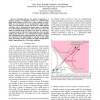Free Online Productivity Tools
i2Speak
i2Symbol
i2OCR
iTex2Img
iWeb2Print
iWeb2Shot
i2Type
iPdf2Split
iPdf2Merge
i2Bopomofo
i2Arabic
i2Style
i2Image
i2PDF
iLatex2Rtf
Sci2ools
CDC
2010
IEEE
2010
IEEE
Delayed decision-making in bistable models
Switching between two modes of operation is a common property of biological systems. In continuous-time differential equation models, this is often realised by bistability, i.e. the existence of two asymptotically stable steadystates. Several biological models are shown to exhibit delayed switching, with a pronounced transient phase, in particular for near-threshold perturbations. This study shows that this delay in switching from one mode to the other in response to a transient input is reflected in local properties of an unstable saddle point, which has a one dimensional unstable manifold with a significantly slower eigenvalue than the stable ones. Thus, the trajectories first approximatively converge to the saddle point, then linger along the saddle's unstable manifold before quickly approaching one of the stable equilibria.
| Added | 13 May 2011 |
| Updated | 13 May 2011 |
| Type | Journal |
| Year | 2010 |
| Where | CDC |
| Authors | Laura Trotta, Rodolphe Sepulchre, Eric Bullinger |
Comments (0)

